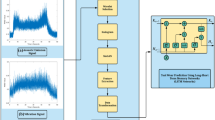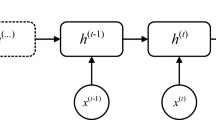Abstract
Computer aided Interpretation of Ultrasonic signals depicting flaws in weld pieces is depicted in this work. In this work, feasibility of Long Short Term Memory (LSTM) for flaw characterization is studied. Owing to the advantage of LSTM, the first technique involves training LSTM directly with the signals as inputs and testing its ability to characterize the flaws from the input signals. Due to wide variation in the length of input sequences, which introduced sparseness in other sequences, overall accuracy is affected. Hence in the second technique, LSTM are trained with features of the signals and it is found that the overall accuracy for test data is 67.64%. These features are statistical parameters obtained from the approximation co-efficient of the input signals. The input signals are decomposed with a novel wavelet template.













Similar content being viewed by others
REFERENCES
Nauman Munira, Hak-Joon Kima, Jinhyun Parka, Sung-Jin Songa, and Sung-Sik Kang, Convolutional neural network for ultrasonic weldment flaw classification in noisy conditions, https://doi.org/10.1016/j.ultras.2018.12.001
Esther Florence, S., Vimal Samsingh, R., and Vimaleswar Babureddy, Artificial intelligence based defect classification for weld joints, IOP Conf. Ser.: Mater. Sci. Eng., 2018, vol. 402, p. 012159. https://doi.org/10.1088/1757-899X/402/1/012159
Licheng Liu, Long Chen, Philip Chen, C.L., Yuan YTang, and Chi Man Pun, Weighted joint sparse representation for removing mixed noise in image, IEEE Trans. Cybern., 2017, vol. 47, no. 3, pp. 600–611.
Mojškerc, B., Kek, T., and Grum, J., Ultrasonic disbond detection in adhesive joints, Proc. 14th Int. Conf. Slov. Soc. Non-Destr. Test. Application of Contemporary Non-Destructive Testing in Engineering (Bernardin, Slovenia, September 4–6, 2017), 2017.
Hochreiter, S. and Schmidhuber, J., Long Short Term Memory, Neural Comput., 1997, vol. 9, no. 8, pp. 1735–1780. https://doi.org/10.1162/neco.1997.9.8.1735
Sudheera, K. and Nandhitha, N.M., Computer aided radiograph interpretation tool for defect characterization from weld plates, Russ. J. Nondestr. Test., 2019, vol. 55, no. 6, pp. 481–488. https://doi.org/10.1134/S1061830919060081
Varun Gupta, Ramveer Singh, Gavendra Singh, and Rajvir Singh, An introduction to principle component analysis and its importance in biomedical applications, 2011 Int. Conf. Life Sci. Technol., Singapore, 2011, vol. 3, pp. 29–33.
Wang Xiaokai, Guan Shanyue, Hua Lin, Wang Bin, and He Ximing, Classification of spot-welded joint strength using ultrasonic signal time-frequency features and PSO-SVM method, Ultrasonics, 2019, vol. 91, pp. 161–169. https://doi.org/10.1016/j.ultras.2018.08.014
Author information
Authors and Affiliations
Corresponding authors
Rights and permissions
About this article
Cite this article
Sudheera, K., Nandhitha, N.M., Sai, V.B. et al. Deep Learning Techniques for Flaw Characterization in Weld Pieces from Ultrasonic Signals. Russ J Nondestruct Test 56, 820–830 (2020). https://doi.org/10.1134/S1061830920100083
Received:
Revised:
Accepted:
Published:
Issue Date:
DOI: https://doi.org/10.1134/S1061830920100083




